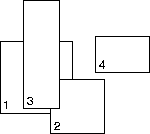You'll be implementing an algorithm and program for manipulating rectangles by sliding them around on a plane. Although rectangles are two-dimensional figures, it will be helpful to think of them as being three dimensional, having a slight thickness as if they were made from paper.
A rectangle is defined by the end-point coordinates of one of its diagonals.
Either diagonal may be given.
A rectangle x1 y1 x x2 y2 encompasses the point (xp yp) if
andmin(x1, x2) < xp < max(x1, x2)
Notice that a point on the edge of a rectangle is not encompassed by the rectangle.min(y1, y2) < yp < max(y1, y2)
Two rectangles overlap if there exists at least one point (including a point on the edge) of one of the rectangles that is encompassed by the other rectangle. Notice that two rectangles sharing only a common edge don't overlap.
If two rectangles overlap, one of the rectangles is above the other; the rectangle that is not above is below. For example
rectangle 1 is below rectangle 2; rectangle 2 is above rectangle 1.
Every rectangle has a level, which is a finite, non-negative integer defined as
- A rectangle that is not above any other rectangle has level 0.
- A rectangle R that is above one or more rectangles has level L + 1, where L is the largest level of any rectangle below R.


